|
Turkey Trotter
Charlie Trotter's calls reflect the spirit of a turkey call-making artist.
STORY BY P.J. PEREA
PHOTOS BY CHAS. J. DEES
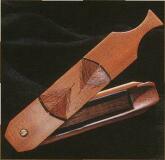
No, this Charlie Trotter is not the well-known chef from Chicago who creates works of art from food. This is the southern Illinois native Charlie Trotter, who creates works of art from stone, wood, bone, antler and whatever other natural material suits his needs. His calls may look like they belong in a museum display case, but they really are meant for reproducing the sweet spring tones of lovelorn toms.
"I started hunting for turkey around 1986 or 1987," recalled Trotter. "I took my first bird with a factory-made call."
Trotter, like many Illinois hunters, was quickly bitten by the turkey hunting bug. But, unlike most. Trotter's next action took him on a slightly different path.
"Once I got my first bird, I decided to make my own call and use it to take my second bird," Trotter said.
So he took the wing bones from his first bird and fashioned a yelper call and harvested his second bird using his homemade creation. It is rather appropriate that it was a wingbone yelper that turned Charlie Trotter, the hunter, into Charlie Trotter, the hunter/call maker.
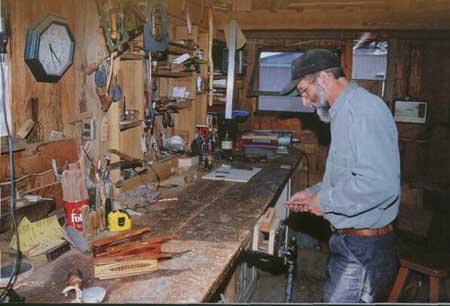
April 2002 5
|
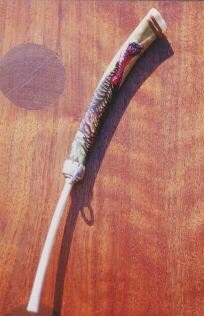
Meticulous attention to detail is what you'll find in Trotter's turkey calls, from the finely painted turkey found on the wingbone yelper above, to the precisely wood-burned feather filaments on the paddies of the box calls and relief
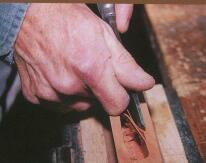
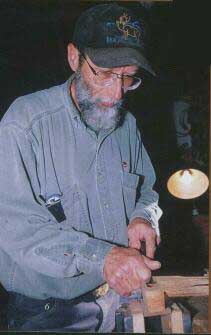
|
The wingbone call is one of the ancient tools used by Native Americans to lure wary turkeys into bow range. Pre-settlement Native Americans made everything they needed by hand and borrowed the raw materials from the land around them. They had a connection and reverence for the land—the same type of connection and reverence that inspires the primitive style of Trotter's calls.
His approach is to create as much of each call as possible from natural materials found in the rolling hills surrounding the Shawnee Forest of Southern Illinois. Occasionally, he uses materials that are rather hard to come by in Illinois, such as elk sinew or slate, but they still are all natural.
His small workshop overlooks the timber stands and agricultural fields near his home in Anna, where he finds both inspiration and raw material in the surrounding land. From the forests come wood logs that serve as the base, bodies and beads in his creations. From the earth emerges bull's eye chert, a type of flint which he uses as an acoustic friction surface. (This is the same type of material used to make primitive flint arrowheads.) And from the woodland creatures come the bones, leather, antler and sinew. Trotter's educational background is in Native American archeology, which he studied at Lincoln Land Community College along with metalsmithing and art courses. Trotter spent nearly five years working with the Illinois State Museum on Native American archaeological digs and also worked with Southern Illinois University analyzing Native American artifacts.
"I have a real appreciation for the simplicity of primitive style tools," he stated. So it comes as no surprise that his calls reflect much of this style and philosophy.
His calls have garnered accolades from turkey hunters and call collectors. The National Wild Turkey Federation (NWTF) awarded two first-place honors for his walnut scratch box call and Stone Maiden friction call in its 1999 Grand National Decorative Turkey Call Competition. In 2001, Trotter's hackberry and walnut scratch box call, won second place in the NWTF competition.
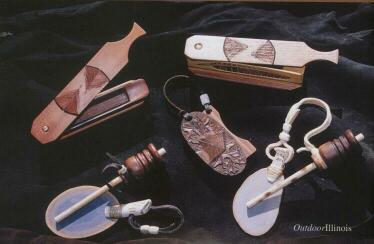
|
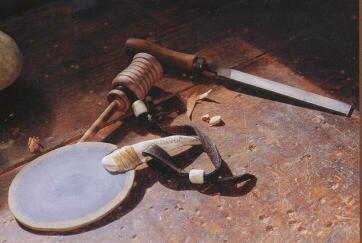
| Trotter's Stone Maiden won the NWTF Championship for the decorated calls
|
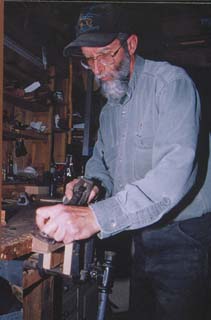
|
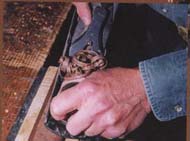
Each one of Trotter's calls is carefully hand-crafted, drawing upon his skills as a craftsman, artisan and hunter.
|
The flint striker surface of his Stone Maiden calls was collected on a friend's local farm. The fragrant red cedar used in some of his scratch box calls came from the bottomland forests of southern Illinois. Native walnut, yellow poplar and cherry resonate sweet notes from his box calls. Tanned leather deer hide, elk sinew and antler pieces connect, bind and adorn his calls. You likely will not find anything of the sort with a factory call made of "space-age polymers."
Trotter says he is always pleased to hear from hunters across the country who have purchased his calls over the years. Like a proud papa, he likes to know that his calls were involved in some memorable hunts.
"I kind of live vicariously through my calls," he said. "Whenever a hunter successfully takes a turkey while using one of them, I feel like I was part of the hunt."
Along with his line of turkey calls. Trotter also crafts furniture, self bows, arrows and black powder shooting accessories.
If you are lucky enough to own one of his calls (which tend to sell very quickly), it's surely tempting to place it on display to show off to your hunting buddies. But to truly appreciate the beauty of the piece, you need to take it out and talk to some toms and jakes this spring. Just be ready to experience what other hunters have found out about Trotter's calls.
They sound as beautiful as they look.
|
Calling all collectors
Charlie Trotter makes several styles of calls, including wingbone yelpers, cane yelpers, scratch box calls, slate and glass pot calls and his distinctive Stone Maiden.
For those interested in owning an outstanding example of Illinois folk art. Trotter can be contacted at P.O. Box 6, Anna, IL 62906.
Those interested in collecting calls or learning more about turkey call makers will find Earl Mickel's book, Turkey Call Makers Past and Present: The Rest of the Best, to be a great reference. For more information, write: Earl Mickel, R.R. #1, Box 1977, Beach Lake, PA 18405.
|
Trotter checks the surface of his Stone Maiden call.
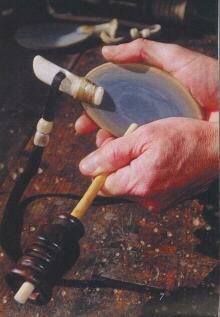
|
|

